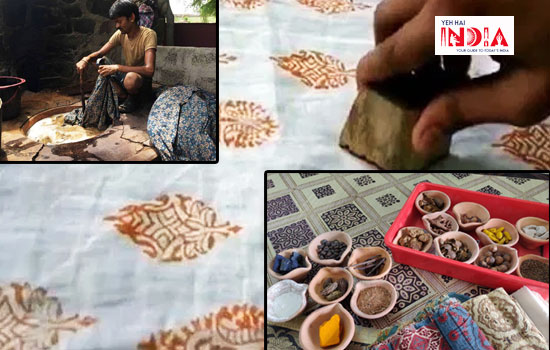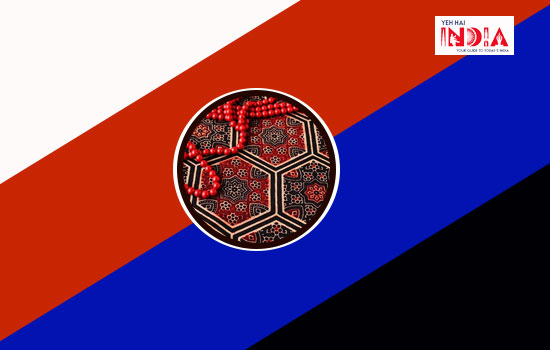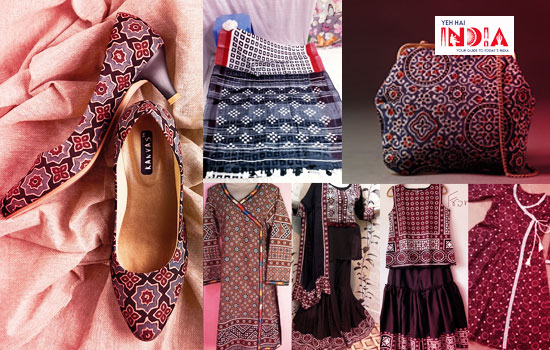The vibrancy and colours in Gujarat can be felt and witnessed at every step. The state is not only known for its architectural marvels, age old temples, various cultural and heritage products, cuisine or the grand scale celebrations that take place during festivals especially during Navratri but is also known for its rich hand loom and handicrafts culture which imbibes the richness of the bygone era.
The state is famous for its amazing ‘Textile Crafts’ which is an epitome of rich culture and heritage of the state and how it has been preserved since the beginning to date. . Printing is a unique feature that the state carries and these techniques are carried forward by different communities. One such printing technique is the well-renowned – Ajrakh Print.
Recommended Story – Chikankari- The Exceptional Art of Embroidery
Ajrakh – Meaning
‘Ajrak’ is a Sindhi word that comes from Persian language ‘Ajar’ or ‘Ajor’ meaning ‘brick’ and ‘-ak’ meaning ‘little’.
A block-printed textile it is resist-dyed using natural dyes which include madder and indigo. It is made by the ‘Khatri’ community in Kutch and is known for its colour – blue with red and its geometric and floral patterns which are complex in nature. It is also found in Sindh, Pakistan and Barmer in Rajasthan.
It is said that Ajrak signifies the universe because of the colours used. Colour Red is used for Earth, Black for darkness, White for clouds, and Blue for the universe. This form is said to be the oldest, complex, and sophisticated methods of printing.
History – Ajrakh

It is said that the Ajrak craft dates back to early medieval period. Unearthed near Cairo were the scraps of the fragments which were believed had originated from the western India.
Practiced by the Khatri community living in the bank of river Sindh (Indus), the families then migrated to Kutch in the 16th century. They settled down when this craft was recognised by the King of Kutch who invited them along with dyers, printers, potters, and embroiders.
The dyers were specially Khatri Brahmins and after two generations, they converted into Islam and settled in Dhamadka. The reason of settling down was due to its close proximity to a river were the fabrics were washed.
In 1989, after 400 years of being in use, unfortunately the rivers dried and the water levels continued to fall in water wells and tanks. Later in the year 2001, after a massive earthquake occurred in Kutch, the block printers were forced to relocate.
It was later through an initiative taken in coordination with relief NGO’s, a village was built and they finally settled here naming the village ‘Ajrakpur’. Currently, there are over hundred families with their primary income being generated through Ajrak and thirty official block printing workshops.
Features – Ajrakh
The most unique feature of the Ajrakh block printing is that resist printing along with other printing and dyeing techniques is used on a single fabric with the same design.
The process is repeated on both the sides of the fabric which needs precision and skills as it should be in perfect cohesion. The technique uses mud-resist at various stages and one more unique feature being the process of dyeing and printing is done twice in order to enhance and ensure the brightness and brilliance of the colours.
Superimposing is done in such a way that the repletion causes sharpening of the clarity.
For the identification of Ajrak, one needs to look for the fabric which has a red or blue background. Traditionally, only four colours were used – red, indigo, white, and black. The makers of ajrakh believed that the warm and cool colours were good to maintain the body temperature where, blue cools and red warms up the temperature.
Dyes
The craft products made from Ajrak printing technique are made with natural dyes. The products include both vegetable and mineral dyes with Indigo being a key dye.
Intricacies
Block printing is not as easy as it may sound due to it being a laborious effort of precision.

The process starts with the cloth being stretched and pinned onto a table. The printers then smother the wooden blocks and hover them over the cloth making sure that the application is symmetrical.
Once aligned, the block is is placed on the cloth with a heavy-force. The same motion is repeated over hundred times until the cloth is completely covered in three different resist bases.
The cloth is dyed in a base colour and laid under the sun to dry only to rinse and dye it again until the cloth is covered and looks like a crowded murals of colours and motifs.
The white cotton cloth is then placed in water and soda ash container and steamed in order to soften the fabric and washed in running water preferably in a river.
Soap is applied and then dipped in a mixture of oils, squeezed out and then kept overnight. The fabric is then washed the next day and soaked in a mixture of sakun seeds and oil and put to dry after which it the colour that gets on the fabric is dull beige.
Specially designed blocks are used to print the fabric in gum by using an outline block. The second line of printing known as the ‘kat’ printing uses the solution of ferrous sulphate and ground seeds giving it a black colour. When it is dyed in alizarine (red) it turns black.

After the third printing with a resist made of natural elements, the fabric is dyed in indigo. The fabric is washed and dyed in alizarine producing red colour in the areas which were covered with resist. Another shade of blue is produced while second time dying is done in indigo.
Then comes the time of final wash that consists of successive washing in soda ash and later in water where detergent is added and finally in the running water too which produces this bright and beautiful product.
Recommended Story – Karomi: The Handloom Tree
Blocks
Finely chiselled printing blocks are used for this printing technique made by the experts in the field.
To get the dovetail effect, there is a set of three blocks which is used in order to get the desired design. These are specifically carved from the ‘Acacia Arabica’ trees, indigenous to the Singh region.
Just by using simple tool, a block-maker carves the pattern which is transferred to the block with great precision. To get an exact inverted image on the other side, they are carved in pairs.
On the fabric, the most commonly observed pattern is dots between the two lines. All the dots are of the same radius in all almost all the designs. Initially these dots were carved out by hands though later, brass nails are used to fill the spaces between the two walls.
Through these designs one can see the deep influence of the Mughal era. Strong geometry was followed to form the patterns and these patterns were formed by the interaction of two or more circles.
The blocks of this craft has taken inspiration from the Muslim architectural elements that form the – Mizan (balance and order). The grid system was followed for repeat patterns.
Modern Day Use of Ajrakh

In the present times, Ajrak has found a special place and has become increasingly popular amongst the block print lovers. Post the earthquake that happened years ago, the Ajrak craft status has moved from a local tribal caste dress to a catwalk worthy craft.
The moving status has led to funds and dedication from brands in order to focus on the innovation of the block print. Along with techniques, new colours have also come on board.
The technique was mostly used for turbans and lungis, however presently; you can see this technique in creating stunning silhouettes, dupattas, kurtas, skirts, scarves, and so on.
If you are a fan of ethnic fashion and have a keen interest in exploring the ancient marvel pieces in the form of crafts then Ajrak is worth the try!
Also Read – Are you an Indian traditional block prints lover? Here’s all you need to know










